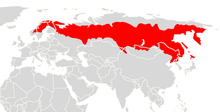Myodes rufocanus
| Grey red-backed vole | |
|---|---|
 |
|
| Scientific classification | |
| Kingdom: | Animalia |
| Phylum: | Chordata |
| Class: | Mammalia |
| Order: | Rodentia |
| Family: | Cricetidae |
| Genus: | Myodes |
| Species: | M. rufocanus |
| Binomial name | |
|
Myodes rufocanus (Sundevall, 1846) |
|
 |
|
| Range of Myodes rufocanus | |
| Synonyms | |
|
|
The grey red-backed vole or the grey-sided vole (Myodes rufocanus) is a species of vole. An adult grey red-backed vole weighs 20-50 grams. This species ranges across northern Eurasia, including northern China, the northern Korean Peninsula, and the islands of Sakhalin and Hokkaidō. It is larger and longer-legged than the northern red-backed vole (Myodes rutilus), which covers a similar range and it is also sympatric with the Norwegian lemming (Lemmus lemmus).
The grey red-backed vole has a reddish-coloured back and grey sides. It has a head and body length of 4.5 to 5.25 in (114 to 133 mm) and a tail length of 1 to 1.75 in (25 to 44 mm). It can be distinguished from the bank vole by its larger size and distinctive reddish back and from the northern red-backed vole by its larger size, longer legs and relatively longer tail. Unlike some other species of vole in the genus Myodes, the molar teeth of adults are rooted in the jaws.
The grey red-backed vole is native to northern Europe and Asia. Its range extends from Norway, Sweden and Finland eastwards through northern Russia to the Kamchatka Peninsula. It includes the Ural Mountains, the Altai Mountains, northern Korea, Sakhalin Island, Japan, northern Mongolia and China. Its altitude range extends from sea level to 1,170 m (3,839 ft) in Scandinavia and to 2,700 m (8,858 ft) in the Khangai Mountains in Mongolia. Its typical habitat is dense undergrowth or rocky areas in coniferous or birch forests, often near rivers, but it is also found in clear cut areas of forests, rough grassland, subarctic shrubby heathland and dry peat bogs.
The grey red-backed vole feeds on grasses and small herbs, the leaves and shoots of sub-shrubs and berries. It prefers the bilberry (Vaccinium myrtillus) to the northern crowberry (Empetrum nigrum ssp. hermaphroditum) which contains unpalatable phenolic substances.
...
Wikipedia

